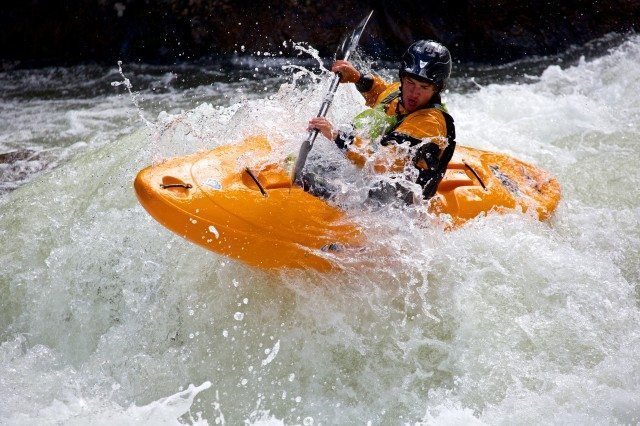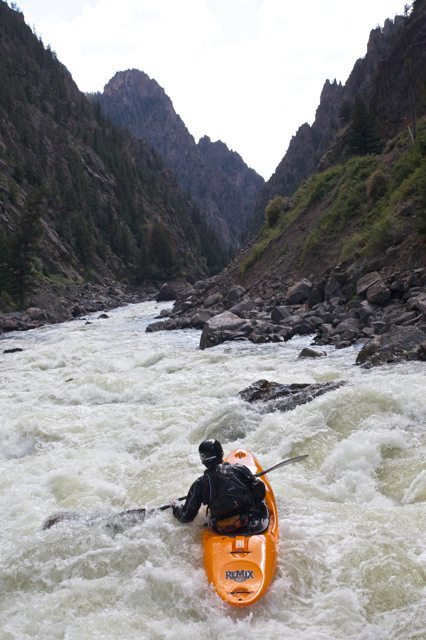Boat: Liquidlogic Remix 79

Type: Whitewater, river runner
Length: 8’11”
Width: 26.5”
Volume: 79 gallons
Weight: 46 lbs
Hull Type: Displacement
Reviewer Vitals: 5’10’’, 170 lbs, 30 inseam, shoe size 9
Days tested: 14
Test locations: Robe Canyon, WA (highwater); Gore Canyon, CO; Barrel Springs/Shoshone, CO; and Bailey, CO
The Liquidlogic Remix 79 is designed to act like a modern river runner with the fast, carvy feel of an old school long boat. To accomplish this, the designers gave the boat a long waterline, low profile, and a displacement hull.
These features make for a very fast boat that eats up big water, but its speed and carving ability come with a few sacrifices in the realm of more technical creeking.
Design
In many ways, the Remix 79 is a throwback to an older time. It is relatively long and low volume compared to other similar boats in the river runner class, and its volume distribution and waterline make it look more like an older long boat than a modern river runner. In this way, it’s true to its name—a remix of old and new design features in a boat that’s still very relevant in today’s lineup.
The Remix’s relatively long overall length combined with a low rocker profile means it has a lot of its hull in contact with the water. The boat tracks well in a straight line and carries a lot of speed through rapids because of this.
The boat’s 79 gallons are mostly distributed between the bow and the back of the cockpit, making for a fairly squished down and low-volume stern.
The Remix also has a displacement hull and soft edges, a design that runs counter to conventional river runner wisdom. For example, Wavesport Diesel, Dagger Mamba, and Pyranha Burn all accomplish their “carviness” with aggressive edges on planing hulls. But it’s the Remix’s length and waterline that improve its carving ability, while its rounded hull makes rolling and eddy catching easier for beginners.

Performance
- Big Water
This is where the Remix really shines. Because of its speed and tracking ability on the high water runs of Robe Canyon, I was comfortable punching into big hydraulics and knowing that I would come out the other side pointing downstream and where I wanted to be.
I did notice that I needed to keep my body position forward through these sorts of features or I could backender easily because of the Remix’s low volume stern. I found moving the seat forward a bit helped with this problem.
I had a blast carving the Remix into huge, wide eddies on big water. Carrying a lot of speed, I could usually get the boat to carve a long arc deep over boily eddy lines and into the eddy. It took me a couple of days to get used to setting a more perpendicular angle to the eddy current in order to account for the boat’s tracking, meaning that I would carry less downstream angle into an eddy turn. By applying this technique, I was eventually able to make sharp, clean turns into small micro eddies as well.
I found that the only drawback to the Remix’s long waterline was that if I did get knocked sideways or off line, it was more difficult for me to turn back on track and make corrections than if I was in a creek boat like my Nomad 8.5.
Of course, comparing the Remix to the Nomad 8.5 is like comparing apples to oranges, but I can say that other river runners such as the Pyranha Burn are also easier to make corrections in because their hard edges can be engaged and disengaged by the paddler at any time. The Remix’s long waterline, on the other hand, is always going to be there whether you want it to be or not.
- Steep Creeking
I didn’t get along so well with the Remix on runs that required quick turns and constant adjustment. In classic Colorado mank on Bailey Canyon, I felt like the boat’s tracking kept me too locked in and didn’t allow me to make the moves I wanted to make between the many rocks that litter the run.
Even on Gore Canyon in Colorado, which has a bit more volume than Bailey, I felt like the boat was too difficult to turn for my liking. This improved somewhat after I moved the seat forward from its initial position, but I still would have liked to be able to engage turns faster in the current.

The low rocker profile that gives the boat so much speed and allows it to punch through big foam piles also detracts from the boat’s boofing ability.
I usually like a boat that lets me pull my bow up over anything. In the Remix, I had to pull really hard on my boof stroke to land flat off of ledges or pull my bow up over small foam piles and seams that would have been a piece of cake in a boat with more rocker. The Remix partially compensates for this drawback with its ability to maintain stability while subbing through a hole, but I personally prefer to keep my bow up.
NEXT PAGE: For Beginners

Home sweet huckboat.
Unless they recently went back to the metal open brackets, LL is shipping the boats with webbing loops now to restrain the backband. Makes it a bit harder to flip up and out, but it’s so easy to just pull a whole side out that you can do that instead.
I’ve only back endered once in it, but I probably would have been beaten the same way, even if I was paddling a small moon. It is absolutely addictive how it snaps into eddys and carries speed. If found as long as I’ve got the space for leverage it can come around petty quick, but when I’m really tucked into a micro eddy above a drop then I’ve got to think about what the hell I’m doing.
I’m 6’4″ and ~ 160 with size 11 paws and I love the 79 for versatility. It would be fun to have the 69 around for the stuff I’m super familiar on, but it’s a tight enough fit that heading off int the middle of nowhere with it would be sketchy.